|
On the Bench
Setup: All objective tests were conducted outdoors away from any reflective
structures, with the subwoofer sitting on the ground plane. The microphone
was also placed on the ground plane, facing the active woofer at a distance
of 2 meters from the width and depth center point of the cabinet.
DSP settings on the RT-12d for all outdoor objective testing were as
follows: Volume 0, EQ Mode "Flat", low-pass Filter Off (LFE Mode), Phase 0
degrees. The auto-EQ Room Correction feature was not used for outdoor
testing.
Frequency Response: A subwoofer with a flat frequency response will sound
even and linear across the entire pass band. And the deeper a subwoofer can
extend, the better it will be able to reproduce pipe organ music, industrial
music with synthesized bass, or the LFE spectaculars found on many DVDs.
The frequency response was measured with a 45 second reverse sine sweep from
200 to 10 Hz. The output of the sweep was adjusted to approximately 85-90 dB
over the mid-bass region. Data resolution is 1/24 octave with no smoothing
applied.
The RT-12d frequency response measured 40-155 Hz
± 3 dB, and 23-190 Hz
±
5 dB. The FR is characterized by a down-sloping response from 60 Hz to 30
Hz, then flattening from 30 Hz to 23 Hz. The response rolls off quickly
below 23 Hz, being 13-14 dB down by 20 Hz.
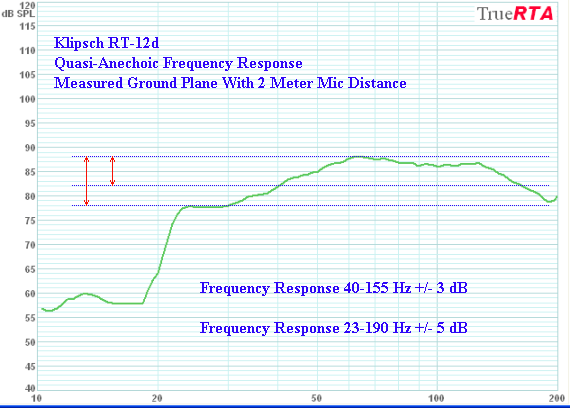
Output Compression: As playback level is increased, any subwoofer will
eventually reach its linear output limits. These limits are usually first
reached at the deepest frequencies. This phenomenon is known as output
compression, and can be caused by exceeding the thermal and/or mechanical
limits of the active drivers, or the air flow limits of the ports, or the
mechanical limits of passive radiators. Output compression can also be
caused by amplifier limiter circuits engaging to prevent subwoofer overload.
The goal of this test is to determine how loud the subwoofer can play before
its frequency response becomes non-linear. It is also useful to assess the
extent and severity of any compression at progressively higher sweep levels.
A subwoofer which remains compression-free at loud sweep levels will sound
powerful and dynamic on demanding music and DVD passages. Conversely, a
subwoofer which exhibits significant compression will have poor dynamics at
high playback levels, with the deepest passages lacking power and impact
relative to the mid-bass passages.
Output compression was evaluated with a 30 second reverse sine sweep from
100 Hz-10 Hz. Sweeps were conducted at progressively louder (3 dB)
increments. The RT-12d demonstrated an outstanding power response,
exhibiting virtually no deep bass compression right up to the maximum output
limits of the subwoofer – bravo Klipsch. At the higher sweep levels, there
was only moderate compression noted in the 50-100 Hz region. At the highest
sweep level, the RT-12d exhibited uniform compression across the entire pass
band, indicating amp limiter intervention, so the test was terminated at
this sweep level.
Klipsch claims a maximum output level of 120 dB @ 30 Hz @ 1M in a 1/8-space
(corner loaded) test environment. This equates to 102 dB @ 30 Hz @ 2M in an
outdoor ground plane setting. I measured 102.5 dB @ 30 Hz @ 2M ground plane
during the output compression test, thus verifying this output claim.
It should be noted that the RT-12d cabinet shuddered noticeably at the
deepest frequencies. This is a result of using passive radiator cones which
are not mounted directly opposed. As a result, the passive radiator reactive
forces are not completely canceled. This cabinet rocking motion at deep
frequencies is normal behavior for this type of design, and should not be
cause for concern if observed by the user.
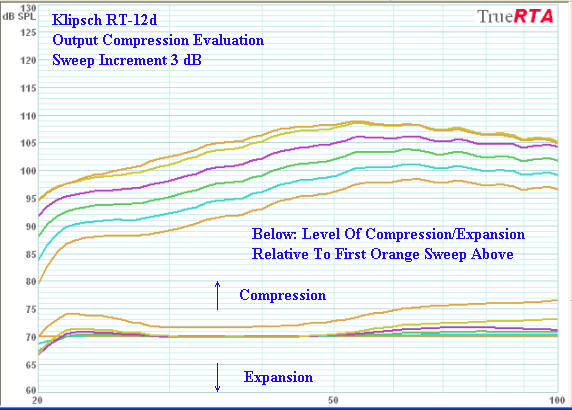
Harmonic Distortion: Harmonic distortion occurs when multiples of the
fundamental signal are produced by the woofer due to non-linear
(electromotive or mechanical) driver or passive radiator behavior. As the
subwoofer is pushed louder, it will start to create progressively higher
levels of harmonic distortion, and this will eventually manifest itself as
audible distortion during playback.
The Consumer Electronics Association has developed the CEA 2010 standard to
assess the distortion-limited output in subwoofers. This standard is based
on the premise that distortion harmonics become easier to hear and more
objectionable with increasing order. Accordingly, the CEA 2010 standard uses
progressively lower stepped limits for the higher order distortion
harmonics. The subwoofer is tested at discrete frequencies, and the output
is increased until any distortion harmonic threatens to exceed a stepped CEA
limit, or the output is electronically limited - whichever occurs first
(sometimes the two events are coincident). The sound pressure at that point
is then noted.
Shown below are the screen shots for test frequencies at 20, 22, 25, 32, 40,
50, 63, and 80 Hz. Each screen shot shows the total sound pressure level,
the % total harmonic distortion (THD), the stepped CEA 2010 limits, and if
the output was capped by the CEA 2010 limits or was electronically limited
(or both). If the output was capped by the CEA 2010 limits, the specific
distortion harmonic(s) are also identified. The information in the screen
shots is summarized in the below table for easy reference.
At the 40 Hz test frequency, the RT-12d generated a disproportionately high
amount of upper order (7th-13th) distortion harmonics, which were audible
during the testing. This behavior could not be duplicated at any other test
frequency. Maximum output at 40 Hz was both electronically limited and
capped by the CEA limits for the 12th and 13th order distortion harmonics.
|
Frequency (Hz) |
Sound Pressure (dB) |
THD
(%) |
Amp Limited |
CEA 2010 Limited |
CEA 2010 Limiting
Distortion Harmonic Order(s) |
|
20 |
90.5* |
15.2 |
- |
X |
10th |
|
22 |
95.0 |
10.0 |
X |
- |
- |
|
25 |
98.0 |
4.8 |
X |
- |
- |
|
32 |
103.8 |
7.6 |
X |
X |
9th |
|
40 |
107.7 |
5.2 |
X |
X |
12th, 13th |
|
50 |
109.4* |
13.3 |
X |
- |
- |
|
63 |
109.6* |
18.9 |
X |
- |
- |
|
80 |
106.0* |
15.4 |
X |
- |
- |
*For readers interested in drawing comparisons to previously reviewed
subwoofers, the RT-12d generated the following sound pressures with a 10%
THD limit: 87 dB @ 20 Hz, 107 dB @ 50 Hz, 105 dB @ 63 Hz, 102 dB @ 80 Hz.
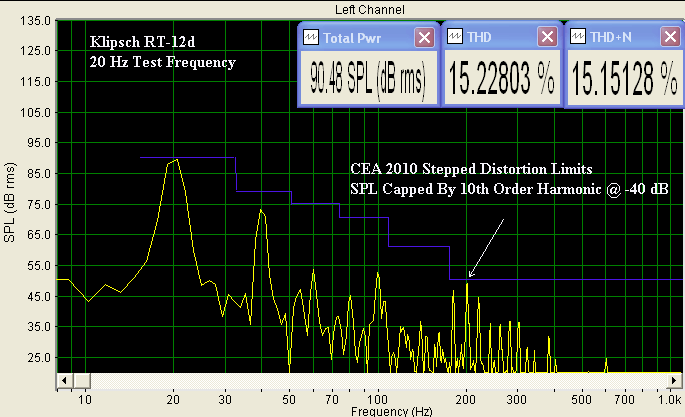
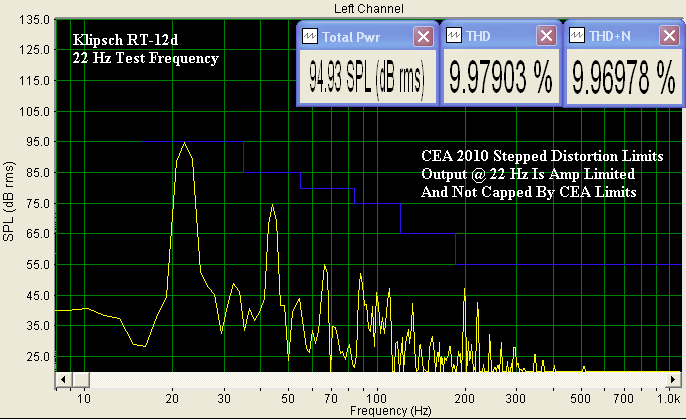
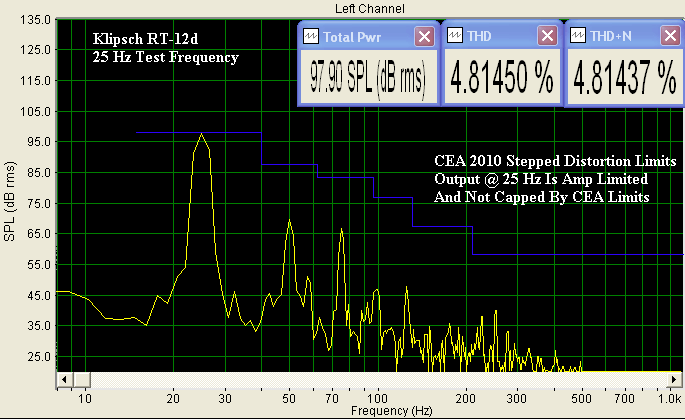
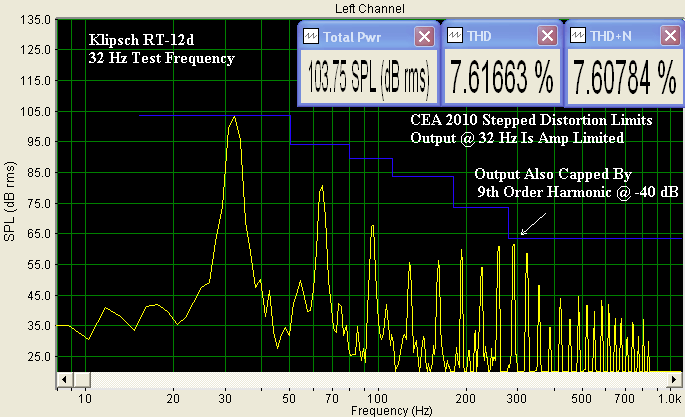
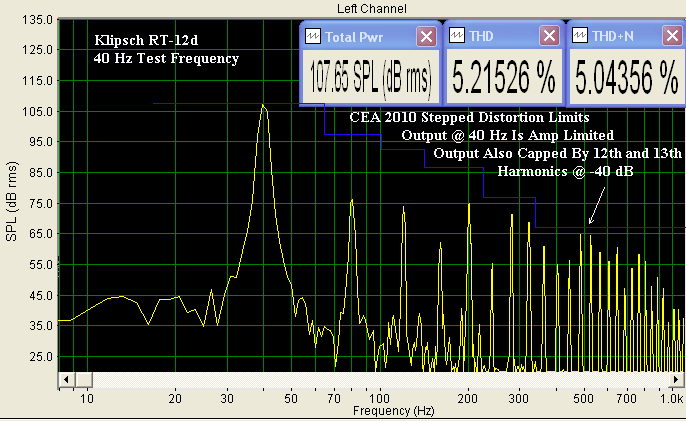
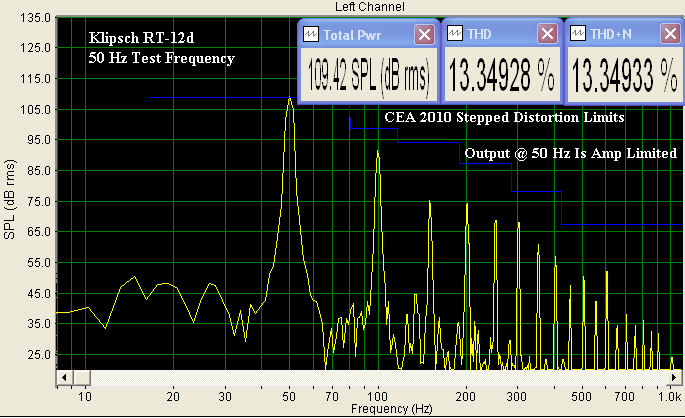
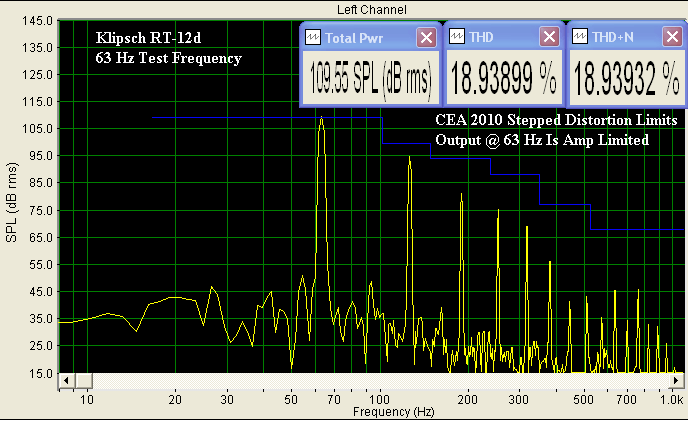
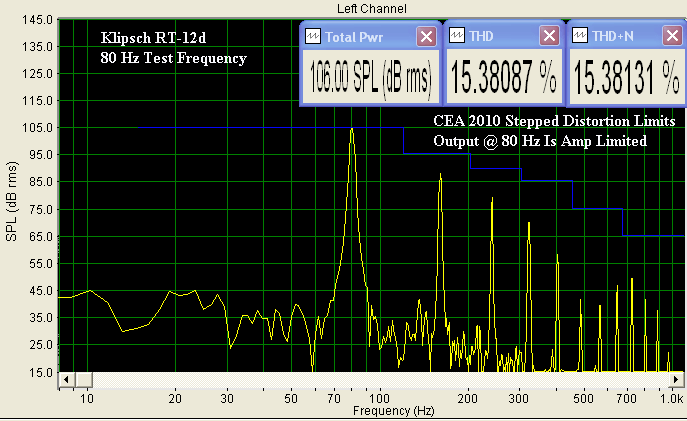
Click Here to Go to Part III.
Terms and Conditions of Use
|













